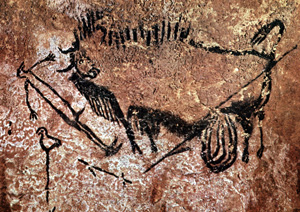|

An exploration of how and why places become invested with SACREDNESS and how the SACRED is embodied or made manifest through ART and ARCHITECTURE
LASCAUX
Many caves have been invested with sacredness (cf. The Sacred Cave). The earliest known example of a sacred cave is that discovered in 1940 at Lascaux in France [see a map showing the location]. Although there is much debate over the meaning of the engraved, drawn, and painted animals which decorate the walls and ceiling of the main cavern (known as the 'Hall of the Bulls') and various steep galleries and passages, their very existence in this dark interior space leaves little reason to doubt that the cave, and others like it, were considered sacred by the people who decorated them [see a plan of the cave].
The paintings were done on a light background in various shades of yellow, red, brown, and black.

--- Bibliography:
|
|






